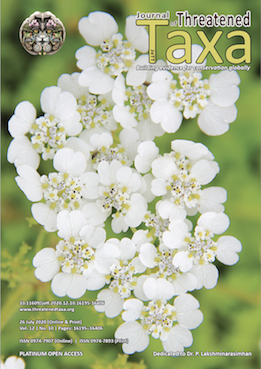Detection of hemoparasites in bats, Bangladesh
Main Article Content
Abstract
A cross sectional study was conducted (2010–2013) to determine the diversity of hemoprotozoa among bats of Bangladesh. Microscopic examination of blood smears (N=533; Pteropus medius (377), Rousettus leschenaultii (111), Megaderma lyra (45)) revealed 9% of bats (95% confidence interval CI: 7–12%) were positive for hemoprotozoa. The overall prevalence of hemoparasites among P. medius was 5% (n=20, 95% CI: 3–8%); where Babesia sp. was 3% (n=12, 95% CI: 2–5%) and Hepatocytis sp. was 2% (n=8, 95% CI: 1–4%). Moreover, 13% of R. leschenaultii were positive (n=14, 95% CI: 7–20%) where prevalence of Babesia sp. was 10% (n=11, 95% CI: 5–17%) and prevalence of Hepatocystis sp. was 3% (n=3, 95% CI: 1–8%). Twenty-nine percent (n=13, 95% CI: 16–44%) of M. lyra harbored hemoparasites, among which 20% (n=9, 95% CI: 10–35%) were Babesia sp. and 9% (n=4, 95% CI: 2–21%) were Hepatocystis sp. The study indicates bats remain important hosts for various zoonotic parasites and suggests further research.
Article Details
Authors own the copyright to the articles published in JoTT. This is indicated explicitly in each publication. The authors grant permission to the publisher Wildlife Information Liaison Development (WILD) Society to publish the article in the Journal of Threatened Taxa. The authors recognize WILD as the original publisher, and to sell hard copies of the Journal and article to any buyer. JoTT is registered under the Creative Commons Attribution 4.0 International License (CC BY), which allows authors to retain copyright ownership. Under this license the authors allow anyone to download, cite, use the data, modify, reprint, copy and distribute provided the authors and source of publication are credited through appropriate citations (e.g., Son et al. (2016). Bats (Mammalia: Chiroptera) of the southeastern Truong Son Mountains, Quang Ngai Province, Vietnam. Journal of Threatened Taxa 8(7): 8953–8969. https://doi.org/10.11609/jott.2785.8.7.8953-8969). Users of the data do not require specific permission from the authors or the publisher.
References
Calisher, C.H., J.E. Childs, H.E. Field, K.V. Holmes & T. Schountz (2006). Bats: important reservoir hosts of emerging viruses. Clinical Microbiology Review 19(3): 531–545.
Christe, P., R. Arlettaz & P. Vogel (2000). Variation in intensity of a parasitic mite (Spinturnix myoti) in relation to the reproductive cycle and immunocompetence of its bat host (Myotis myotis). Ecology Letters 3(3): 207–212.
Christensson, D.A. (1989). Inverse age resistance to experimental Babesia divergens infection in cattle. Acta Veterinaria Scandinavica 30(4): 453–464.
Gardner, R.A. & D.H. Molyneux (1987). Babesia vesperuginis: natural and experimental infections in British bats (Microchiroptera). Parasitology 95(3): 461–469.
Godfrey, Jr. R.D., A.M. Fedynich & D.B. Pence (1987). Quantification of hematozoa in blood smears. Journal of Wildlife Disease 23(4): 558–565.
Epstein, J.H., V. Prakash, C.S. Smith, P. Daszak, A.B. McLaughlin, G. Meehan, H.E. Field & A.A. Cunningham (2008). Henipavirus infection in fruit bats (Pteropus giganteus), India. Emerging Infectious Diseases 14: 1309.
Hornok, S., P. Estok, D. Kovats, B. Flaisz, N. Takacs & K. Szoke (2015). Screening of bat feces for arthropod-borne apicomplexan protozoa: Babesia canis and Besnoitia besnoiti-like sequences from Chiroptera. Parasites & Vectors 8(1): 441.
Khan, M.A.R. (2001). Status and distribution of bats in Bangladesh with notes on their ecology. Zoos’ Print Journal 16(5): 479–483. https://doi.org/10.11609/JoTT.ZPJ.16.5.479-83 DOI: https://doi.org/10.11609/JoTT.ZPJ.16.5.479-83
Lord, J.S. (2010). Micro and macroparasites of bats (Chiroptera). PhD Thesis, University of Salford, Manchester. http://usir.salford.ac.uk/id/eprint/9737/
Manwell, R.D. & R.E. Kuntz (1966). Hepatocystis in Formosan mammals with a description of a new species. Journal of Protozoology 13(4): 670–672.
Marinkelle, C.J. (1996). Babesia sp. in Colombian bats (Microchiroptera). Journal of Wildlife Disease 32(3): 534–535.
Nartey, N.A.N. (2015). Common parasites of fruit-eating bats in Southern Ghana: MPhil Thesis. Department of Animal Biology and Conservation Science, University of Ghana, XV+144pp. http://ugspace.ug.edu.gh/handle/123456789/8892
Olival, K.J., E.O. Stiner & S.L. Perkins (2007). Detection of Hepatocystis sp. in Southeast Asian flying foxes (Pteropodidae) using microscopic and molecular methods. Journal of Parasitology 93(6): 1538–1540.
PREDICT One Health Consortium (2017). PREDICT operating procedures: Bat sampling methods, 1–13pp. https://ohi.sf.ucdavis.edu/sites/g/files/dgvnsk5251/files/files/page/predict-sop-bat-sampling-2017.pdf
Rahman, M.A., M.J. Hossain, S. Sultana, N. Homaira, S.U. Khan, M. Rahman, E.S. Gurley, P.E. Rollin, M.K. Lo, J.A. Comer & L. Lowe. (2012). Date palm sap linked to Nipah virus outbreak in Bangladesh, 2008. Vector-Borne and Zoonotic Diseases 12(1): 65–72.
Schaer. J., D.M. Reeder, M.E. Vodzak, K.J. Olival, N. Weber & F. Mayer (2015). Nycteria parasites of Afrotropical insectivorous bats. International Journal of Parasitology 45(6): 375–384.
Schaer, J., S.L. Perkins, J. Decher, F.H. Leendertz, J. Fahr & N. Weber (2013). High diversity of West African bat malaria parasites and a tight link with rodent Plasmodium taxa. Proceedings of the National Academy of Sciences 110(43): 17415–17419.
Schaer, J., S.L. Perkins, I. Ejotre, M.E. Vodzak, K. Matuschewski & D.M. Reeder (2017). Epauletted fruit bats display exceptionally high infections with a Hepatocystis species complex in South Sudan. Scientific Reports 7(1): 6928.
Thurber, M.I., R.R. Ghai, D. Hyeroba, G. Weny, A. Tumukunde & C.A. Chapman (2013). Co-infection and cross-species transmission of divergent Hepatocystis lineages in a wild African primate community. International Journal of Parasitology 43(8): 613–619.
Wilson, K.R., O.N. Bjornstad, A.P. Dobson, S. Merler, G. Poglayen, S.E. Randolph, A.F. Read & A. Skorping (2002). Heterogeneities in macro-parasite infections: patterns and processes, 6–44. In: Hudson P.J., A. Rizzoli, B.T. Grenfell, H. Heesterbeek, A.P. Dobson (eds.) The Ecology of Wildlife Diseases. Oxford University Press, New York, 216pp.
Zhang, Y.Z. & E.C. Holmes. (2020). A genomic perspective on the origin and emergence of SARS-CoV-2. Cell 26. DOI: https://doi.org/10.1016/j.cell.2020.03.035

